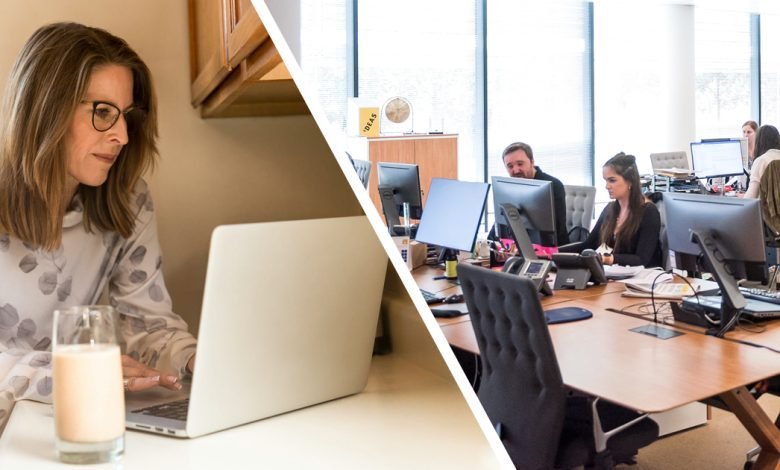
A hybrid workplace is one that facilitates employees to split their workdays between home and office space. According to the research firm Gartner, remote working has increased from 17% in 2019 (pre-pandemic) to 32% in 2021 by the global workforce. As companies started adapting to the drastic changes brought by the pandemic, from creating socially distant cubicles to rotational in-office working for employees, a hybrid workplace is naturally developing as a viable option for future workplace culture.
However, when a business operates with both onsite and remote employees, integrating their communication and contributions brings with it business challenges. Building a hybrid workplace requires a long-term strategy that is consistent and powered by technology for business success.
Integrate the digital and physical experience
Use efficient web-based communication and project management tools that bridge the gap between in-person and remote employees. Implement a superior communication tool with internet access, and ease of use that will equip employees to integrate their information whether while working remotely or during their in-office days. Design office spaces for employee engagement in digital-plus-physical spaces that can equally engage in-office and remotely connected employees in a meeting. Angled or mobile tables, in-room microphones, and easy-to-move markerboards and displays can make the experience of the meeting seamless and inclusive for both co-located and remote workers.
Reinvent traditional office spaces
Be open to creating collaboration spaces with movable boundaries for quick stand-up and hybrid meetings. Allocate enclosed spaces like cubicles for individual-focused work. This can improve the innovation and fluid approaches to co-create in meetings and keep the rhythm of visual and acoustic privacy that people have got used to while working from home.
Promote a fluid workspace
Establish a fluid workspace that can flex as needs change, and that will continue to maintain the coherence of communication across co-located and remote employees. A transparent team will help accelerate innovation and advance the culture of the organization. This also helps the business optimize the real estate investments for workspace.
Balance individuality and team collaboration
A study conducted by the Gensler’s Research Institute shows full-time work-from-home employees saw a drop of 37% in average collaboration time. Ensure that there is a well-laid-out structure for employees to come together to work as a team, promote ideas, and co-create but also focus individually to complete their assigned tasks. While working from home exclusively could heighten productivity, team collaboration drives engagement and fosters innovation.
Dedicated leaders to bridge collaboration
Have a dedicated cross-departmental team comprising of executive leadership, HR and IT work together to build a hybrid workplace that works. The HR leader focuses on maintaining employee engagement and performance while the IT member ensures cyber-related safety is achieved with team communication and the senior leadership makes necessary business decisions to financially support the workplace needs.
Define the hybrid work policy
There should be a clearly documented hybrid workplace policy that outlines when and how employees can choose to work in a hybrid model. The hybrid strategy should be tailored according to the job’s needs. For instance, jobs that are heads-down and focused require fewer days at the office while jobs that require teams to work closely together to make quick decisions may require greater presence at the office.
Create a role for hybrid workplace safety compliance
In view of the pandemic, reassure your employees of a safe workspace that they can thrive in without causing anxiety about their health. Appoint a compliance officer who can oversee the creation and enforcement of safety policies with respect to return to office during the pandemic and make his/her presence known to the workforce. Employees should be made aware of vaccination mandates, accommodations for people with health issues, and basic safety measures such as temperature screening that will be implemented when they return to the office. For offline employees, secure connectivity is a critical enabler to keep them working safely from home. A compliance officer caters to monitoring and safeguarding needs of both co-located and remote employees to help build an efficient and safe hybrid workplace.
Prioritize mental health and stress-reduction
Incorporate strategies to address employee mental health in a hybrid work environment that addresses work stress through online yoga, and meditation techniques. Encourage casual connections at the workplace through structured team-building activities, games or off-work-related conversations. Conduct team get-togethers where there are opportunities for full-time remote employees to connect with their onsite colleagues. This helps nurture professionalism and trust within the team and maintains the synergy in a hybrid workplace.
Treat online and offline workers equally
When building a hybrid workplace, it is important to make sure both on-site and remote employees are treated equally. While assessing the employee efficiency, judge based on data of the individual’s productivity and goals accomplished and never by their physical presence at the office. Even if some employees spend very little time in the office, relatively their contributions could be greater or at par with their onsite peers. This should not be overlooked and hence it is important to keep communications, tracking, and monitoring transparent at a hybrid workplace.
Organize and plan team collaboration
Create a clear agenda and share necessary information with teams before meetings to make the meetings productive. Schedule the meeting time in advance to make sure everyone is available in their respective time zones if applicable. Make information accessible to everyone via cloud communication tools.
Facilitate multiple modes of communication
To keep up with co-located and remote colleagues through virtual communications do not restrict to a single mode of communication. While some communications happen over emails some others occur via calls. Facilitate collaboration and exchange of information through more than one channel depending on the circumstances and convenience. Use web-based conference tools like Clariti that facilitate multi-mode virtual communications.
Stay transparent and open in communication
Employees feel empowered when they know how they fit into the company and how their contributions affect other colleagues and departments. At a hybrid workplace, the offline presence of some co-workers could pose a challenge in understanding their perspectives and honest feedback regarding operations and communication. Conduct anonymous surveys that employees can provide regular feedback on, covering possible gaps that are usually unnoticed but build tension in a hybrid workplace. Bridging gaps and fixing issues of business communication between on-site and remote workers encourages integrity and close cooperation between on-site and off-site team members.
The pandemic has accelerated the shift to move to a hybrid workplace model for businesses. A Harris Poll/Sungard AS survey found that while 43% of people would ideally prefer to not return to the office at all, 51% would choose a mix of remote and on-site work. It is an opportunity for businesses to implement the evolving business needs as organizations that don’t keep up with change are likely already losing out in the “Great Resignation.” Building a hybrid workplace is the need of the day and organizations need to stay relevant as we step into the Metaverse where digital and hybrid events will play a key role in business development in the future.



